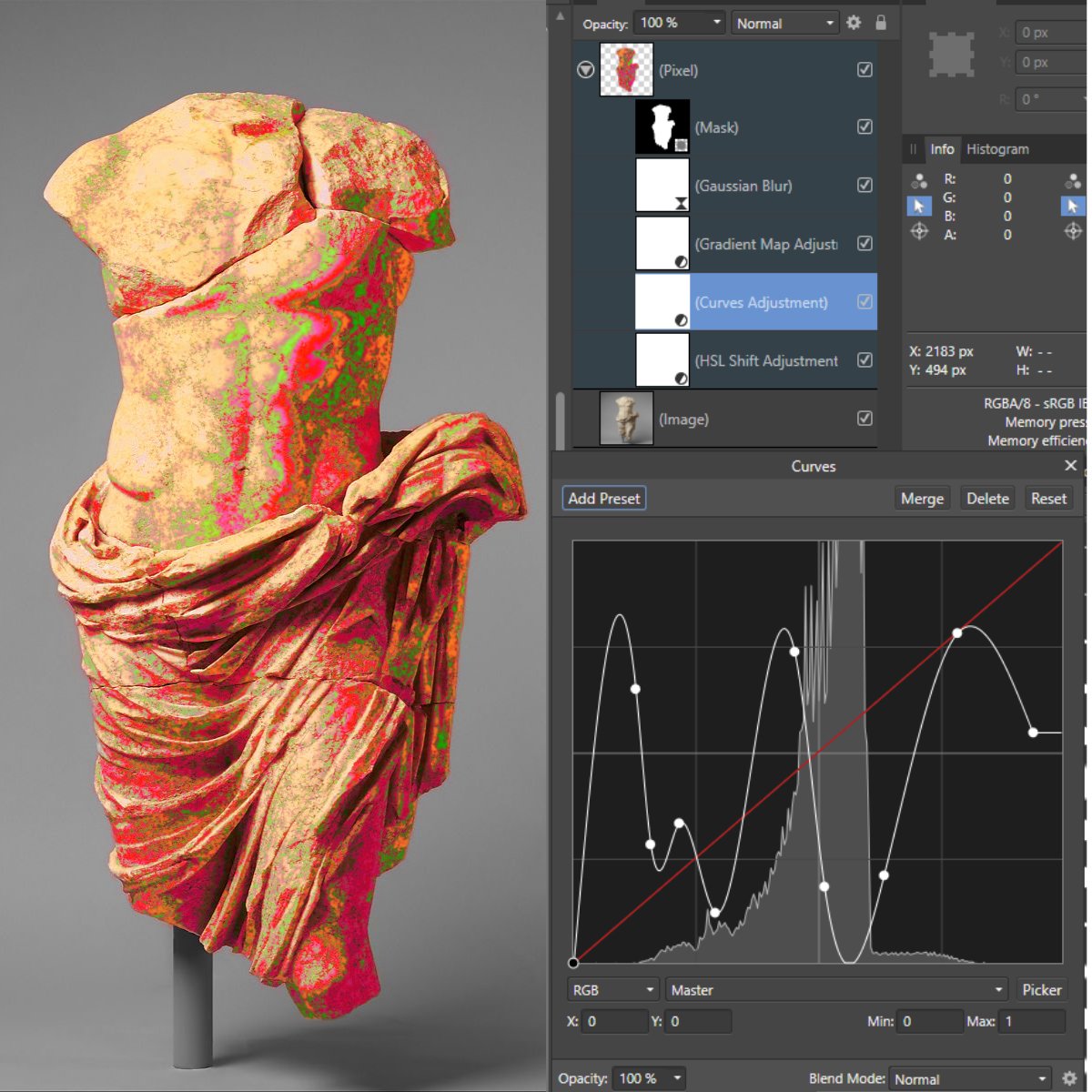-
Posts
582 -
Joined
-
Last visited
Everything posted by Andy05
-

Managing fonts
Andy05 replied to mynnzer's topic in Pre-V2 Archive of Affinity on Desktop Questions (macOS and Windows)
It's actually surprisingly lightweight on the system—considering this app's features. As for experience with it, see my previous post (like @walt.farrell mentioned). -

Managing fonts
Andy05 replied to mynnzer's topic in Pre-V2 Archive of Affinity on Desktop Questions (macOS and Windows)
Since you're using FontBa.se, it's quite easy. Firstly, I'd start with organising the fonts, if not done yet. Organise them into separate folders like "Serif", "Sans-Serif", "Gothic", "Display", "Handwritten" etc. Add those folders to auto watch in Fontbase. An incredibly powerful feature, it'll add fonts automatically to the list if you copy them into the folders. No need for manual scanning for new fonts anymore... These steps are not really necessary, but they will make the search for fonts faster (and font handling less confusing in general). Now, when you open a document in Publisher, it'll tell you, which fonts are missing. Fontbase has a quite good search feature. Search for the font (top search bar) and activate it. Search for the next font, activate. Rinse and repeat until you've activated all fonts. Publisher will replace the fonts automatically after you've activated them! You don't need to assign them manually. At least it does so when running Windows (10). Once you're done with the document, deactivate the fonts in fontbase again. This way, you'll run your OS with only as little fonts as needed for daily use. -
In addition to the two examples above, I'd start with some different approach. With this method, the original shapes, lines and shadows are maintained. Here's a (very!) quickly done low-res example. But with some fine-tuning it should provide the wanted results. These are the steps used (every step gets added as a layer above the previous one, all of them applied to the masked object): duplicate the image mask the object desaturate the masked object (I used HSL, but B/W would work as well, maybe even better, depending on the motive) add a curve like shown in my example, go wild with the nodes! Add a gradient map (here's where you pick your colours, the more "rainbow-ish", the better). In this case, I added a gaussian blur (was needed due to low res source) set the masked object's blend mode to a setting, which will blend the colours to the original underneath (e. g. overlay)
-
Again, I don't disagree with you about the missing feature. But copypasting the objects into e. g. inkscape, do the perspective distortions, copypasting back into Affinity Designer and export (as 100% true vector) might have taken just a couple of minutes. The conversation with your clients, stating that you couldn't do it, followed by (I assume) more back and forth conversation surely took more time. I still can't see the point you're trying to make. The turnaround time of the professional approach (using tools, which include your features) would have been the quick way, wouldn't it? What I was complaining about was the exaggerated drama you tried to make about the missing feature.
- 317 replies
-
- mac
- free transform tool
-
(and 5 more)
Tagged with:
-
You stated: So, IF you didn't turn down the job, why did you tell such nonsense to your clients? Swear silently about the missing features in your office, but don't tell the client "I can't provide that, 'cause my app won't let me do it!". Again, your whining initial post doesn't make sense. Yes, vector warp should be a feature of Affinity apps. Yes, you can complain about this. But seriously, don't try to argue with "I couldn't do my job properly *sniff*." And yes, that made you look very, very amateurish. You claimed that Affinity needs to know why this feature is important. So, your argument is, that a professional is losing jobs because of this? Really? You just could have stated that you needed to use a different app in order to fulfil your client's task. That'd have been professional. "I had to explain to my client, that I can't do it with my favourite app!" was an amateur's version. That's all.
- 317 replies
-
- mac
- free transform tool
-
(and 5 more)
Tagged with:
-
Seriously? You provided a tearful scenario; why you, as a "professional", had to turn down a client's job, because you couldn't fulfil it with your favourite app. Next time, less drama, please. We both agree, that the vector warp is a sorely missing feature in affinity apps. But if you really can't cope with this problem when dealing with clients, you might have to rethink about your "professional" status, really.
- 317 replies
-
- mac
- free transform tool
-
(and 5 more)
Tagged with:
-
Contradicting yourself much, now? Because, if you do like stated in your last comment, your previous one was nothing but an obsolete, trolling rant: ("...] I couldn't provide that, nor could I provide any explanation for why [...]"). Anyway, a true "professional" would probably post in a more consistent manner...
- 317 replies
-
- mac
- free transform tool
-
(and 5 more)
Tagged with:
-
As much as I agree with the topic of this thread, your comment is kind of weird, if you're really working on a professional base. A professional would just use a different tool, if the currently used ones can't provide the features one needs. As you stated in your comment, there are even free alternatives. So, again, I wholeheartedly agree that a vector warp feature is sorely missing in Affinity Designer—but, as a professional—you'd better come up with an alternative solution for basic tasks for your clients rather than trying to explain that you're using tools, which won't let you fulfil your clients' requests. A real professional usually has more tools in his bag, especially if some of them don't provide all features one needs.
- 317 replies
-
- mac
- free transform tool
-
(and 5 more)
Tagged with:
-
Depending on what kind of colour is used, it might be even a bit shiny/glossy looking. But I wouldn't work with any 3D effects either. And yes, the skin texture needs to be visible in order to make the result look real. Here are two real-life examples, which might give an idea of how the edit should look like. Covering a huge area to demonstrate the texture effect: Here's a bit more glossy colour: As you can see, the second example is completely opaque, yet the skin texture remains clearly visible.
-
Shutterstock usually rejects EPS files, which can't fulfil their specifications, when you submit them. Unfortunately, it can be tricky at times to find out which of the specification hasn't been met. For vectors, it's usually added FX or some rasterized objects. Shutterstock won't accept some EPS even if they are 100% compatible with Adobe Illustrator V. 8/9.
-
I'm not sure if I misunderstood something here, but if you know the original dimensions/aspect ratio, why not creating a canvas in that size/ratio and then pulling the corners of the perspective destination to its corners? I'm completely with @Old Bruce's suggestion in this matter. Create a new canvas in the correct aspect ratio/dimensions Paste/place image onto canvas Resize (if needed and/or wanted) Open Perspective filter (either live or not, doesn't matter) Chose mode "Source" and move the four corner nodes to the four corners of the distorted source picture in your photo Chose mode "Destination" and pull the four corner nodes to the edges/corners of your canvas Apply filter Done. The result will be a perspective distortion applied to your image to recover the original aspect ratio, basically "undoing" the perspective distortion you've created when taking the photo.
-
Nur am Rande: Falls die Moderationskarten auf Karton gedruckt werden sollen (>120/160g per m²), solltest du auf den automatischen Einzug verzichten und die lieber über den Einzelblatteinzug zuführen. Dickere Papiere/Kartons sollten nie über die normale Papierkartusche gedruckt werden, dafür ist die erste Einzugswalze in einem viel zu kleinen Radius. Das gibt nur Probleme (wenn der Drucker den Karton überhaupt zu fassen und um die erste Walze "gedrückt" bekommt. Da sind schiefe/fehlerhafte Einzüge und Papierstaus vorausbestimmt... Zu deinem Treiber, das scheint der von Microsoft automatisch installierte Treiber zu sein. Versuch' für dein Druckermodell einen Treiber direkt bei Brother herunterzuladen. Der hat deutlich mehr Einstellungsmöglichkeiten. Zumindest ist das der Fall für meine beiden Brother Drucker (DCP-J4120DW und HL-L2350DW). Dort kann ich ohne Probleme auch eigene Papierformate (die Option nennt sich dann "Benutzerdefiniert") angeben.
-
That's something, which only the creator of the PDF files can do as this format isn't meant to be edited by nature, it's a closed format. It's not Affinity Designer's fault per se. "But it works in Adobe's apps" might be true, but that's only because they are leader in the industry and don't care for official standards. They do what they want with their own formats like EPS, PDF, "extending" them with additional streams, which often only Adobe apps can handle as they—of course—don't publish how to handle them in order to make users having to stay with Adobe. You can't blame other software developers for this behaviour. I haven't tested this, but what happens when you place the PDF (passthrough) and then export the layout with the embedded PDF as a (new) PDF, with "convert text to curves" activated? Or, if that doesn't work, place the PDF (passthrough) onto a blank document, export this in a raster format like @Joachim_L suggested. Latter should create a placeable image for your layouts.
-

Graphtec plug-in
Andy05 replied to Whirlybird's topic in Pre-V2 Archive of Affinity on Desktop Questions (macOS and Windows)
Usually even budget cutter/plotters include some kind of software for using them. Even if it's very uncomfortable to use or to design with. But such software typically can deal with at least one vector format or another (PDF/EPS/SVG). So designing a motive in the preferred app, like Affinity Designe, and exporting it so the manufacturer's native software can be used for plotting/cutting is a standard workflow. -
That's actually a good example, for what AI can't do very well (in a professional workflow). The more complex and complicated the selection is, the more AI fails in this task. There are countless of examples at YouTube, which prove even dedicated (and expensive) masking tools not even close as good as manual masking.
-
I'm not sure if I'd like to see (m)any of them in the Affinity apps to be honest. Developing AI driven technologies costs a lot of manpower. I'd rather see that being used for some of the basic functions, which Affinity lacks—even after several years of users complaining about it. As for AI features, there are dedicated tools for that. Sometimes it's better to use multiple apps within one's workflow rather than praying for an all-in-one solution.




